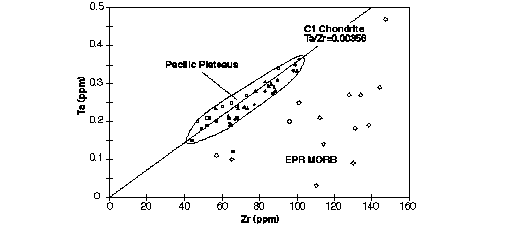
Large volumes of tholeiites erupted during the formation of oceanic plateaus, such as the Ontong Java and Caribbean Plateaus, result from high percentages of partial melting occurring mostly within the spinel peridotite field. Such tholeiites are restricted in their isotopic range, typically displaying positive eNd (+3.4 to +7.6) and eHf. The isotope data show that the source region has been depleted with respect to the chondritic uniform reservoir (CHUR). Paradoxically, however, some incompatible element ratios from these plateaus are identical to C1 chondrite values (McDonough and Sun, 1995), e.g. Ta/Zr = 0.00356 (Fig 1). This contradicts the depleted nature of the source shown by positive eNd values.
The heterogeneous nature of plumes (Kerr et al., 1995), such as those responsible for forming the Caribbean Plateau and Iceland (Zindler et al., 1979), is now well documented. However, the large volumes of melt involved in the production of oceanic plateaus probably involves the remixing of such heterogeneities, either during widespread melting, or in large crustal magma bodies. Thus, plateau tholeiites may offer the most representative sampling of mantle plumes, whereas smaller degrees of melting associated with, for example, ocean islands, are much more selective in their sampling.
Ocean plateaus require large source volumes, and it has been suggested that the lower mantle must be involved in their formation (Coffin and Eldholm, 1993). That these tholeiites have positive eNd and eHf signatures indicates that the lower mantle contains a substantial reservoir that has undergone melt extraction early in Earth history. However, either (i) this melt extraction did not result in reduction of Ta/Zr; or (ii) reassembly of source components fortuitously resulted in chondritic Ta/Zr; or (iii) melting processes fortuitously produced chondritic Ta/Zr.
Coffin, M.F. & Eldholm, O.,Geology 21, 515-518 (1993).
Kerr, A.C. et al., Geology 23, 843-846 (1995).
McDonough, W.F. & Sun, S.S., Chemical Geology 120, 223-253 (1995).
Zindler, A. et al., Earth Planet. Sci. Lett.. 45, 249-62 (1979). 
Fig. 1: Zr versus Ta for thoeliites from Pacific Ocean plateaus. Diamonds are analyses of Pacific MORB (Saunders, unpublished data). Chondritic ratio from (McDonough and Sun, 1995).